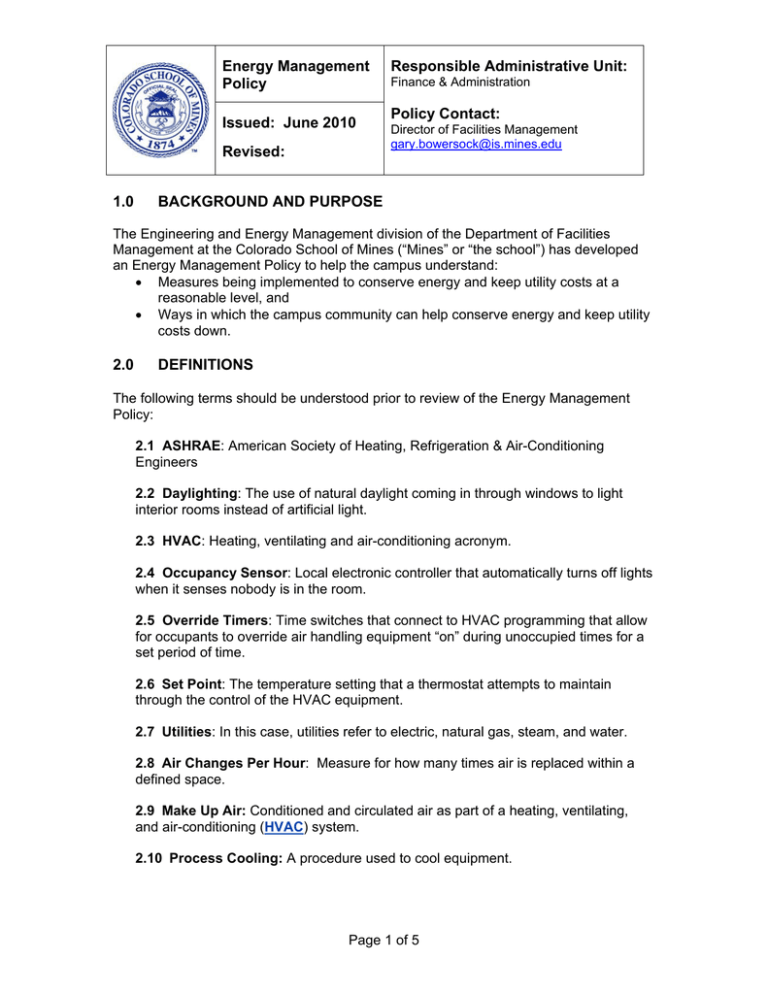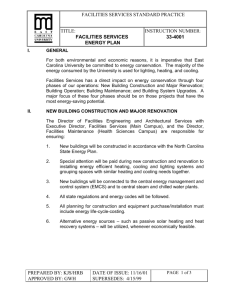Energy Management Responsible Administrative Unit: Policy Policy Contact:
advertisement

Energy Management Policy Issued: June 2010 Revised: 1.0 Responsible Administrative Unit: Finance & Administration Policy Contact: Director of Facilities Management gary.bowersock@is.mines.edu BACKGROUND AND PURPOSE The Engineering and Energy Management division of the Department of Facilities Management at the Colorado School of Mines (“Mines” or “the school”) has developed an Energy Management Policy to help the campus understand: • Measures being implemented to conserve energy and keep utility costs at a reasonable level, and • Ways in which the campus community can help conserve energy and keep utility costs down. 2.0 DEFINITIONS The following terms should be understood prior to review of the Energy Management Policy: 2.1 ASHRAE: American Society of Heating, Refrigeration & Air-Conditioning Engineers 2.2 Daylighting: The use of natural daylight coming in through windows to light interior rooms instead of artificial light. 2.3 HVAC: Heating, ventilating and air-conditioning acronym. 2.4 Occupancy Sensor: Local electronic controller that automatically turns off lights when it senses nobody is in the room. 2.5 Override Timers: Time switches that connect to HVAC programming that allow for occupants to override air handling equipment “on” during unoccupied times for a set period of time. 2.6 Set Point: The temperature setting that a thermostat attempts to maintain through the control of the HVAC equipment. 2.7 Utilities: In this case, utilities refer to electric, natural gas, steam, and water. 2.8 Air Changes Per Hour: Measure for how many times air is replaced within a defined space. 2.9 Make Up Air: Conditioned and circulated air as part of a heating, ventilating, and air-conditioning (HVAC) system. 2.10 Process Cooling: A procedure used to cool equipment. Page 1 of 5 Energy Management Policy Issued: June 2010 Revised: Responsible Administrative Unit: Finance & Administration Policy Contact: Director of Facilities Management gary.bowersock@is.mines.edu 2.11 Supply Diffuser: An air distribution outlet, usually located in the ceiling and consisting of deflecting vanes discharging supply air in various directions and planes, and arranged to promote mixing of the supplied air with the air already in the room. 3.0 POLICY The Department of Facilities Management is responsible for making all decisions and arrangements related to utilities for the campus. Facilities Management is also responsible for paying the utilities bills for the entire campus and managing the utility budget. Facilities Management pays the utility providers for the campus usage in four main areas: steam, electricity, natural gas, and water. Facilities Management is the main point of contact for each of these providers. In addition, Facilities Management functions as the agent for the campus in such areas as rate negotiations, infrastructure and connection decisions and maintenance, contract negotiations, and billing management. These responsibilities are included within the mission of Facilities Management. In certain cases Facilities Management “bills back” other departments for the energy that the department or tenant uses. These situations are determined by the Senior Vice President of Finance and Administration. In most other cases the utility costs are included with the overhead charges that the departments pay for the use of the facilities. 4.0 ENERGY USAGE GUIDELINES Because of the responsibilities inherent in managing campus utilities, the Engineering and Energy Management division of Facilities Management has developed guidelines concerning utilities-related operational aspects of the campus. The purpose of these guidelines is to conserve energy and utilities, while not placing an undue burden on campus occupants or causing disruption to the educational and research missions of the university. These guidelines are as follows: 4.1 Lighting Use Facilities Management encourages the efficient utilization of lighting in the following ways: • Turn off classroom lighting when it is not needed. • Turn off lighting in offices and classrooms when possible to utilize natural daylighting. • Turn off main office lights and use fluorescent task lights, especially in intermittently occupied common offices (like grad student offices). • Turn off lights in classrooms, offices, labs, and other areas when leaving. • Report to Facilities Management through work order system when occupancy sensors appear to not be working. Page 2 of 5 Energy Management Policy Issued: June 2010 Revised: • Responsible Administrative Unit: Finance & Administration Policy Contact: Director of Facilities Management gary.bowersock@is.mines.edu Report other lighting issues to Facilities Management through work order system, such as exterior lights on during day, lights continually left on during unoccupied times, field lights on during times when no athletic activities happening, etc. 4.2 Building Occupancy Schedules Facilities Management strives to make sure HVAC systems are operating when a significant number of occupants are in buildings. At the same time, Facilities Management seeks to limit the amount of time HVAC systems are running in buildings that are not occupied. To this end, Facilities Management is instituting the following guidelines: • In general, buildings are expected to be occupied between the hours of 6 am and 9 pm, M-F, during the spring and fall semesters and 6 am and 6 pm, M-F, during the summer. Facilities Management uses these time frames as a default guideline only and may shorten or increase hours of operation for some or all areas of a building after interviewing and consulting with building occupants. • Facilities Management has the ability to operate certain areas of buildings for extended hours for special circumstances such as critical research experiments or special projects. In the event of special circumstances, the appropriate department head must be notified. Department heads will then notify Facilities Management of the request. Requests must have a defined timeline and be for scheduled occupancy. Facilities Management does not want to run buildings after hours simply for the convenience of someone working or studying during odd hours. However, Facilities Management will consider such cases for afterhours temperature setback to avoid unbearable temperature extremes. • Certain large lecture halls are able to be shut down during non-use but will have operational HVAC whenever the rooms are scheduled through the Registrar’s office. • Facilities Management is exploring the use of override timers for HVAC in certain cases. • Contact the Facilities Management main line for after-hours scheduling requests at 303-273-3330. Procedures for requesting changes to building temperature scheduling are described here. 4.3 Campus Heating and Cooling Set Points Facilities Management has defined the following temperature set points at the recommendation of the Engineering and Energy Management division. These set points are within recommended ASHRAE limits and correlate well with the set points implemented by other institutions of higher education around the state and country. Cooling set point (Occupied) Cooling set point (Unoccupied) 76 degrees F Varies on building and use Page 3 of 5 Energy Management Policy Issued: June 2010 Revised: Heating set point (Occupied) Heating set point (Unoccupied) Responsible Administrative Unit: Finance & Administration Policy Contact: Director of Facilities Management gary.bowersock@is.mines.edu 68 degrees F 60 degrees, but can vary by building These set points are general guidelines but can vary by situation. For example, a lab experiment may require a certain constant temperature for a set amount of time. Arrangements can be made for these situations. Please discuss these situations with the appropriate department head or fill out a Facilities Management work order. In general, laboratories must be ventilated at a certain minimum air changes per hour 24 hours/day, 7 days/week. The above set points will not interfere with those requirements. 4.4 Laboratory Use Facilities Management recommends the following procedures for laboratory users. • Close fume hood sashes when not in use. The amount of air volume that is used is decreased tremendously when the sash is closed. Heating and cooling make up air for laboratory exhaust is probably the most expensive energy cost. • The use of domestic water for process cooling is strongly discouraged. It is a wasteful use of one of our most precious resources. In some cases, this practice may be allowed for a temporary situation until mechanical process cooling can be provided. • Turn off laboratory equipment when it is not required. • Consult with Facilities Management when considering purchasing new equipment. Select the most efficient equipment possible and consider facility needs. See the Facilities Management Services Policy for information on purchasing equipment. • Do not leave laboratory doors open to an adjacent corridor. This creates air balance problems and is against building code. 4.5 Computers and Office Equipment The following recommendations are being provided for office users. • Turn off office equipment when not in use. • Make sure computer monitor power saving devices are employed. Screen savers do not save energy. • Turn off monitors and unplug chargers and other types of equipment when leaving for the day. Facilities Management is working with CCIT to determine the best policy for shutting off CPUs when not in use. • Consolidate office appliances such as coffee pots and refrigerators into common ones as much as possible. • Share printers and copiers whenever possible and turn them off at the end of the day. Page 4 of 5 Energy Management Policy Issued: June 2010 Revised: Responsible Administrative Unit: Finance & Administration Policy Contact: Director of Facilities Management gary.bowersock@is.mines.edu 4.6 Miscellaneous Energy Saving Guidelines • • • • • • • Utilize blinds to reduce cooling loads. The use of portable heating devices such as space heaters is strongly discouraged. These devices are very inefficient and expensive to operate. Report heating and cooling issues to Facilities Management through the work order system. Facilities Management and CCIT are encouraging the consolidation of servers into the existing data center machine rooms. In general, Facilities Management does not support cooling of individual data closets dispersed throughout the campus buildings. Do not seal off supply diffusers or exhaust vents. This will disrupt the proper air balance of the system. Report problems to Facilities Management. Do not try to “trick” thermostats with things like bags of ice, hot cups of water or wet rags. These techniques don’t work and make problems worse. Report comfort issues to Facilities Management. Do not leave windows open when leaving a space, and do not prop doors open permanently. Conserve water as much as possible by not leaving water running and taking shorter showers if using the recreation center or dormitories. 5.0 OPERATIONAL STRATEGY Mines is committed to bringing a sustainable environment to campus. Facilities Management is always looking at new technologies and ideas to incorporate into the campus buildings and grounds. These new strategies are evaluated based on a life cycle cost analysis point of view and impact to the campus mission. New strategies that are acceptable will be incorporated into the Facilities Management Campus Standards. Please contact Facilities Management with any new ideas for energy savings. 6.0 CONTACT INFORMATION See the Facilities Management web page for current contact information. Page 5 of 5

